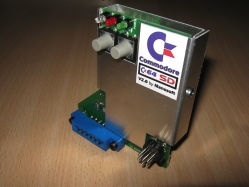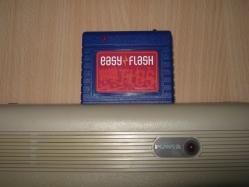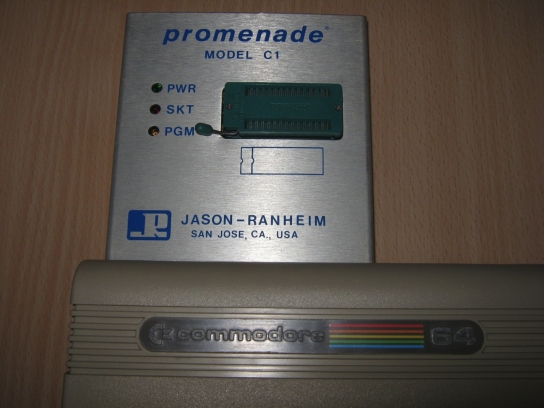 The Hybrid SID is a portable SID Player with a OLED LCD and a USB connector.
The Hybrid SID is a portable SID Player with a OLED LCD and a USB connector.
The Hybrid SID plays the most common variety of chiptunes, music written for playback on a SID chip. Probably the biggest collection of SID music is the High Voltage SID Collection, which has 36,000 SID tunes, free to download.
This prototype use a real SID chip (6581/8580) for play music and a CUI32 PIC32MX Development Stick for the CPU (6510) Emulation.
A YouTube video is available here.
source: dangerousprototypes.com

Autopsy:
Preview of the new Manosoft C64SD Infinity v2.0.
This project is interesting not only because it’s another mass-storage solution but because it combines already existing solutions to a new and fresh product. Damiano has always followed all the Commdore related websites and forums especially concerning the MMC and SD2IEC projects.
That’s when he got the idea to build a solution for which one doesn’t need soldering, wire cutting or the IEC cable. C64SD utilizes the Datasette pass-through connector to power the SD2IEC circuit. An IEC pass-through connector connects right into the IEC port.
The whole module stand vertical along the back of the C64/128 (or VIC20). The module is fitted with two rather large buttons, one reset and one diskswap/multi-function button.
Remember: with a external power supply the C64SD works fine with Commodore 16/Plus4.
C64SD Infinity new Features:
- TAPE pass-through connector.
- Reset on User Port.
- CPU Type ATMEL ATmega 1284P(128k)
- SD Filesystem for firmware upgrade FAT16/32
- Standard Commodore 128 IEC Cable.
The interface can be purchased on the Manosoft site.
source: manosoft.it youtube.com
 The Sic!Cart (Super Inexpensive Cart) is a low price Flash Cartridge System for the Atari 400/800/XL/XE series computers.
The Sic!Cart (Super Inexpensive Cart) is a low price Flash Cartridge System for the Atari 400/800/XL/XE series computers.
source: atariage.com
 Turbo Chameleon 64 is an extremely user-friendly cartridge that can be used without opening the computer. It is just plugged to the expansion port of the C64.
Turbo Chameleon 64 is an extremely user-friendly cartridge that can be used without opening the computer. It is just plugged to the expansion port of the C64.
The Turbo Chameleon 64 cartridge can also be operated as a stand-alone unit (since it’s basically an FPGA computer like the C-One or the Minimig in a C64 cartridge case), replacing the computer, the floppy drive and the heavy power supply.
When used as a stand-alone unit, a USB power adapter or active USB hub can be used as a power source.
Changelog:
Beta-5 to Beta-5a:
- Fix crash when turbo limit is set in menu without activating turbo. (or when disabling active turbo with button while a limit is set)
- Fix D030 mirror of the turbo bit emulating C128 2Mhz mode with Chameleon turbo.
Beta-5a to Beta-5b:
- Eliminate spurious resets by masking reset line in standalone mode.
- Fix keyboard matrix so joysticks are properly emulated (IR, numpad) in standalone mode.
- Block normal button functions in menu mode (only exception is reboot by pressing 0.7s on right button)
source: syntiac.com
Retro Innovations ROM-el:
To program the ROM-el chip by Retro Innovations you need a Adapter. The ROM-el chip uses a Atmel flashrom AT49F001AN (128K x 8) and we must build an adapter that converts the pins of the 2364 PROM Commodore 64 Kernel, which is used in ROM-el chip, to the original state of the chip AT49F001.
After this work, you can use the Willem programmer to program the FlashROM with one or more C64 kernel.
 Turbo Chameleon 64 is an extremely user-friendly cartridge that can be used without opening the computer. It is just plugged to the expansion port of the C64.
Turbo Chameleon 64 is an extremely user-friendly cartridge that can be used without opening the computer. It is just plugged to the expansion port of the C64.
The Turbo Chameleon 64 cartridge can also be operated as a stand-alone unit (since it’s basically an FPGA computer like the C-One or the Minimig in a C64 cartridge case), replacing the computer, the floppy drive and the heavy power supply.
When used as a stand-alone unit, a USB power adapter or active USB hub can be used as a power source.
Changelog:
- Framebuffer writes now use MMU.
- Framebuffer writes can be switched off (buffer can be used by software)
- Cartridge buttons emulated on PS/2 keyboard (F11,F12 and PrintScreen)
- Chameleon can use real BASIC and Kernal ROMs in machine in cartridge mode.
- Emulated IEC bus can be disconnected from C64 (Chameleon is drive emu)
- FLI bug fixed.
- Added Stereo SID support.
- Turbo feature added.
- Relative CPU speed displayed in VGA debug bar.
source: syntiac.com

Autopsy:
ZoomFloppy is an USB device for connecting Commodore disk drives to your PC. The ZoomFloppy is an improvement based on XU1541 from Till Harbaum.
Nate Lawson and Jim Brain teamed up to produce a professional product. This controller will support IEC drives, IEEE-488 drives and a user-port connection for parallel.
source: go4retro.com ieee488 beta software docs & firmware

Nano SwinSID Prototype by x1541:
This project is based on the microcontroller ATMEGA88PU from Atmel and the emulation code is written by Swinkels.
The prototype of Nano SwindSID is a scaled down version of the Micro SwinSID, so far so good, and here’s my initial impression.
x1541, a user of the forum64.de has made a very nice work, the pcb has the same size of the original SID chip (6581/8580), the components are arranged very well and the entire space of the pcb was used. I can just say to buy it when the Nano SwinSID kit will be available, your money will be spent well.
Nano SwinSID Features:
- ISP Connector.
- Same size as the original SID.
- 6581/8580 Jumper.
- Smd ATmega.
source: forum64.de
 I’m waiting several years for a new IDE interface for my Atari (XE/XL) computer, and finally is arrived, compacts, economical and very promising.
I’m waiting several years for a new IDE interface for my Atari (XE/XL) computer, and finally is arrived, compacts, economical and very promising.
some features:
- Is not much greater than a 2,5-inch IDE disk.
- Does not require an external power-supply.
- Contains an XE (CART+ECI) connector, an XL (PBI) connector, a cartridge port, and a connector for a 2,5-inch IDE disk.
- Contains 96 KB ISP Flash ROM and 32 KB RAM available to the internal PBI BIOS and flashable from the Atari.
- Contains 512 KB or 1024 KB ISP Flash ROM for SpartaDOS X (or any other cartridge of such type), flashable from the Atari. This ROM can be physically disabled using a dedicated switch. The switch is not installed in the device shown on photos below.
- Contains a real time clock circuitry to be used with SpartaDOS X. If someone doesn’t want to use it, the module is anyway fully compatible with an external R-Time 8 or internally mounted ARC.
- A LED flashing during the I/O.
source: atariage.com

Autopsy:
Personal note (PLA Compatibility): I have tested the EasyFlash cartridge with a Commodore 64 with installed a PLA replacement by Manosoft and it works Perfectly!
I bought mine fully assembled from Mike Betz via Lemon64 Forums.
EasyFlash is a cartridge for the C64 expansion port. In contrast to traditional cartridges, this one can be programmed directly from the C64.
You can easily create various classic computer game cartridges, program collections or even a diagnostic cartridge to track down issues with your hardware with it. All what you need to do this is a C64, an EasyFlash, the software available here and an image of the cartridge (*.crt). As these CRT files may be quite large, a large disk drive like the FD-2000 or an sd2iec may be useful.
EasyFlash is not a freezer cartridge like the Final Cartridge III or the Retro Replay. And it’s no replacement for a 1541 disk drive like the sd2iec.
source: skoe.de/easyflash lemon64.com
This is a very old project published in a Dutch magazine to capture the state of the IRQ for Commodore 64 (vic-20) with a LED. After many years i have decided to make it.
On the photo you can see the project and the right connections on the cartridge port.
 Components:
Components:
- 1 x IC 74LS04.
- 1 x Bicolor LED.
- 2 x 330 ohm resistors.
- Tiny wires.
How it work?
When the CPU generates an IRQ the green LED lights up, otherwise is red, if the irq is turned on and off quickly the led is orange.
 x1541, a user of the forum64.de has decided to scale down and update the pcb of the Micro SwinSID.
x1541, a user of the forum64.de has decided to scale down and update the pcb of the Micro SwinSID.
Download: NanoSwinSID PCB (33.34 Kb)
Features:
- ISP Connector.
- Same size as the original SID.
- 6581/8580 Jumper.
- Smd ATmega.
source: forum64.de

Autopsy:
The Promenade C1 is an EPROM burner that was manufactured in Canada by Jason-Ranheim Co. It plugs into the user port of computers like the Commodore VIC-20 or Commodore 64.
Download: Prom-Shell v2.00 (788)
source: mikenaberezny.com
 The Chipophone is a homemade 8-bit synthesizer, especially suited for live chiptune playing. It has been built inside an old electronic organ.
The Chipophone is a homemade 8-bit synthesizer, especially suited for live chiptune playing. It has been built inside an old electronic organ.
All the original tone-generating parts have been disconnected, and the keys, pedals, knobs and switches rerouted to a microcontroller which transforms them into MIDI signals.
Those are then parsed by a second microcontroller, which acts as a synthesizer.
Here some video examples:
source: linusakesson.net
 The HxC Floppy Drive Emulator is a software and hardware system created by jfdn aka Jeff.
The HxC Floppy Drive Emulator is a software and hardware system created by jfdn aka Jeff.
The aim of this project is to replace the floppy disk drive by an electronic device emulating the floppy disk drive (list of supported Computer/Hardware).
There are two differents emulators:
- A USB version which allows to connect the floppy disk drive interface of the computer to a PC via a USB cable.
- A SDCARD version which allows to emulate floppy disks which images are stored in a SDCARD.
Release notes for the HxCFloppyEmulator software v1.5.1.0:
- New files Support : Jeff Vavasour Color Computer Disk Image format (*.JVC) added.
- Floppy disk dump tool/ HFE conversion : Bitrate value are now corrected.
- Floppy disk dump tool : a small GUI change.
- D88 file format support improved.
- HDM file support : gap len increased to 116.
- FAT12 Floppy Generator enhanced : More FAT12 floppy format available, FAT geometry adjusted/corrected.
- FAT12 Floppy Generator : Sources files on the PC side are now correctly closed in case of fail.
- E-Mu SP1200 support : E-Mu SP1200 RAW file image support added (*.sp1200fd)
- ISO/IBM track generator : Skew/interleave generator bug corrected.
source: hxc2001.free.fr
 The Hybrid SID is a portable SID Player with a OLED LCD and a USB connector.
The Hybrid SID is a portable SID Player with a OLED LCD and a USB connector.













 The Sic!Cart (Super Inexpensive Cart) is a low price Flash Cartridge System for the Atari 400/800/XL/XE series computers.
The Sic!Cart (Super Inexpensive Cart) is a low price Flash Cartridge System for the Atari 400/800/XL/XE series computers. Turbo Chameleon 64 is an extremely user-friendly cartridge that can be used without opening the computer. It is just plugged to the expansion port of the C64.
Turbo Chameleon 64 is an extremely user-friendly cartridge that can be used without opening the computer. It is just plugged to the expansion port of the C64.



















 I’m waiting several years for a new IDE interface for my Atari (XE/XL) computer, and finally is arrived, compacts, economical and very promising.
I’m waiting several years for a new IDE interface for my Atari (XE/XL) computer, and finally is arrived, compacts, economical and very promising.















 Components:
Components: x1541, a user of the
x1541, a user of the 











 The Chipophone is a homemade 8-bit synthesizer, especially suited for live
The Chipophone is a homemade 8-bit synthesizer, especially suited for live  The HxC Floppy Drive Emulator is a software and hardware system created by jfdn aka Jeff.
The HxC Floppy Drive Emulator is a software and hardware system created by jfdn aka Jeff.


Recent Comments